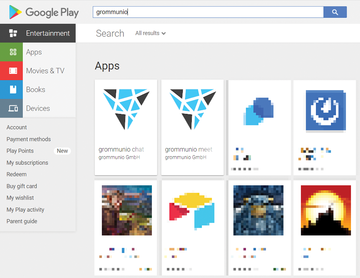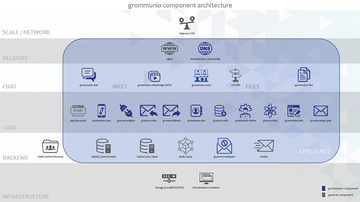
Photo by Gabriel Crismariu on Unsplash
Microsoft Exchange replacement
Top Dog in Sight
For decades, Microsoft Exchange has dominated the enterprise groupware market. Whether as a desktop, mobile, or plain vanilla web application, no competitor has been able to assert itself permanently against Microsoft Exchange. Possible alternatives have proved too clumsy and often lacked comparable features and scalability. Yet the market leader's product has many weaknesses, which opens a huge market opportunity.
A new player appeared on the market in 2021 with the launch of grommunio [1], which advertises itself as a largely complete replacement for Microsoft Exchange. Moreover, the startup promises features such as support for the Messaging Application Programming Interface (MAPI)-over-HTTP protocol, file synchronization (ownCloud), chat (Mattermost), and video conferencing with its own Jitsi fork (Figure 1).
 Figure 1: Video, chat, notes, tasks: Grommunio's original name derives from the claim "groupware and much, much more." © grommunio.com
Figure 1: Video, chat, notes, tasks: Grommunio's original name derives from the claim "groupware and much, much more." © grommunio.com
Exchange Exasperation
Administrators with mixed feelings about Exchange are reticent to use it, and Microsoft is feeling growing resentment among some users. Reasons include vendor lock-in, a general lack of data protection compliance, and the vulnerability of Microsoft's products to malware. Recently, Microsoft had to fix another vulnerability in Exchange that exposed client user data [2]. Many admins feel left out by Microsoft: Policies, strategies, and responses to customer complaints are typically geared for very large installations.
For fans of open source, Exchange adds another problem: It is not based on open standards, and it uses proprietary protocols and APIs like MAPI [3] for internal communication. Clients for Exchange are pre-installed on all Windows, Android, and Apple devices, but Exchange still has a poor reputation when it comes to communicating with external services or third-party clients. Microsoft promises to emulate free standards like the Simple Mail Transfer Protocol (SMTP) or Internet Message Access Protocol (IMAP) but lacks the functions necessary for compatibility.
In light of the advance of cloud-based solutions, many companies are under pressure to hand over their data to corporations like Google, Apple, or Microsoft. Microsoft's flagship products are also heading in the direction of cloud-only offerings. Exchange and other products such as MS Office are increasingly being drawn into this vortex. Although Exchange is still available on-premises, Microsoft is increasingly focusing on cloud products [4].
European companies cannot transfer their data to a third-party cloud, even more so if it is hosted in another jurisdiction or by a company based there. The General Data Protection Regulation (GDPR) and liability and data protection considerations prohibit doing so. When it comes to public administration data or particularly sensitive health data, for example, the restrictions are even tighter, leading to a growing market that needs an alternative to Microsoft Exchange, wherein mail is hosted locally and transparently on the company's own servers and is demonstrably under the control of the operator.
Transparent for Clients
According to the developers, grommunio supports both the aged Remote Procedure Call (RPC)-over-HTTP protocol by Microsoft from 2017 and the newer MAPI over HTTP [5] and offers ActiveSync for mobile devices. In contrast to Exchange, the open source groupware additionally entices users with standard protocols for other clients. The choice extends from CalDAV (calendar) and CardDAV (address book) to a variety of Microsoft Exchange protocol extensions.
According to the manufacturer, a grommunio instance can be integrated easily into an existing Windows Active Directory (AD) domain. Linux provides the operating system (openSUSE, Ubuntu, Red Hat, Raspberry Pi OS), which makes the solution significantly more robust against malware and hackers. Like its competitors, grommunio comes with a number of typical add-on services that allow you to manage individual notes and tasks; to communicate by chat, video, and audio telephony; and to exchange files with a sync tool. For example, the modular component architecture lets you integrate chat with a simple command like:
zypper in grommunio-chat
Version 2021.08.1 introduced a menu for the setup routine, from which admins can select or deselect modules.
Grommunio claims that the choice of clients for the basic feature set is almost unrestricted – thanks to open standards. However, for the time being, features beyond those offered by Exchange are only available with the web interface. Apps for mobile devices are on the roadmap, and apps already exist for Chat and Meet (Jitsi) in the Google Play store (Figure 2). As a client, grommunio accepts any (mobile) Exchange client that connects by ActiveSync or other protocols. Users do not notice whether they are adding the new account on a real Exchange or on grommunio. After entering a username and password, the client goes about providing service in the usual way. Grommunio plans to provide features not supported by the Microsoft API or vendor protocols – file synchronization, calls, chat, video conferencing – with separate apps.
 Figure 2: Grommunio is constantly and rapidly evolving: The August 2021 version introduced many new features, including a migration wizard and two apps in the Google Play store for meetings and chats.
Figure 2: Grommunio is constantly and rapidly evolving: The August 2021 version introduced many new features, including a migration wizard and two apps in the Google Play store for meetings and chats.
Scaling by Sharding
Like Exchange, grommunio uses sharding to scale seamlessly (Figure 3). Essentially, this involves distributing horizontally partitioned databases across multiple hosts. Transparent to the user, grommunio can use multiple shards located on different servers by simply adding another server or cloud account to the storage back end when space becomes scarce.
Unlike its competitors, grommunio uses a MySQL database for the metadata only and stores content data (e.g., mail and groupware objects) in a SQLite database for each user. The platform allows multidomain and multitenant setups and runs with any POSIX-compliant storage back end, according to the vendor.
Buy this article as PDF
(incl. VAT)
Buy ADMIN Magazine
Subscribe to our ADMIN Newsletters
Subscribe to our Linux Newsletters
Find Linux and Open Source Jobs
Most Popular
Support Our Work
ADMIN content is made possible with support from readers like you. Please consider contributing when you've found an article to be beneficial.







